Wheat: How to Introduce Your Baby to this Potentially Allergenic Food
- Why there is more benefit to introducing wheat foods to your baby early and often vs. withholding these foods.
- A variety of ways to introduce wheat to your baby using baby-led weaning foods that babies can safely self-feed from 6 months of age on
- Why concerns about feeding your baby grain foods are mostly bogus (...with a few exceptions), but spoiler alert: almost all babies CAN safely digest grain & wheat foods
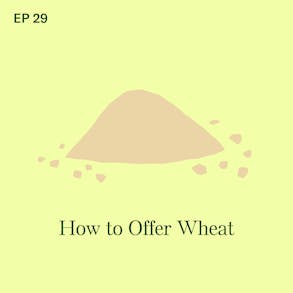
LISTEN TO THIS EPISODE
Episode Description
How do you feed your baby wheat? Wheat is one of the Big 8 allergenic foods...the 8 foods that account for about 90% of food allergy. And it’s one of the easier foods to introduce early and often for your baby.
In this episode you will learn some easy ways to introduce your baby to wheat foods for baby-led weaning. And we’ll also cover why some people say babies should not have or can’t digest wheat foods and why that is not true (...unless your baby has a true wheat allergy!)

Links from this Episode
- Baby-Led Weaning with Katie Ferraro program with the 100 First Foods™ Daily Meal Plan, join here: https://babyledweaning.co/program
- Baby-Led Weaning for Beginners free online workshop with 100 First Foods™ list to all attendees, register here: https://babyledweaning.co/baby-led-weaning-for-beginners
Other episodes related to this topic:
- Episode 183 - Bread: When Can Babies Safely Eat Bread?

Latest Episodes
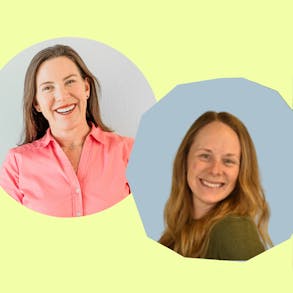
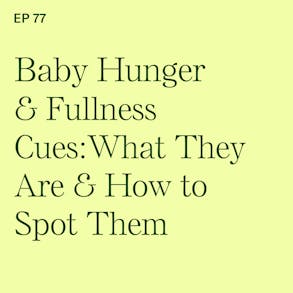
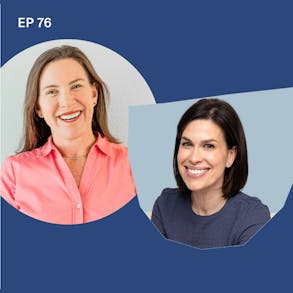
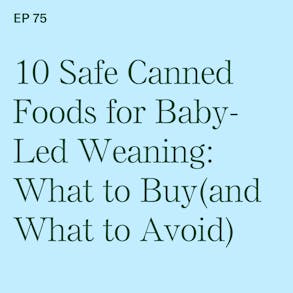
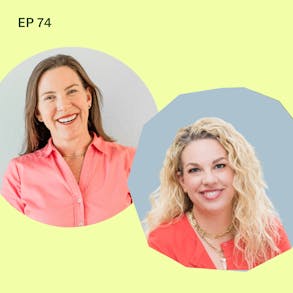
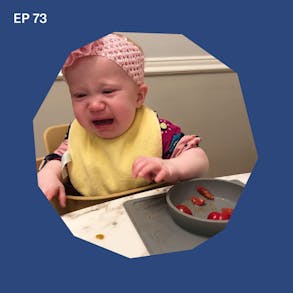
Katie Ferraro (0s):
Are you about to start solid foods but you don't know where to start? Or maybe you started with some purees and now you want to make a switch? The best place to get started learning about starting solid foods safely is my one hour online video workshop called Baby-Led Weaning for Beginners. I just rerecorded this free training and it's packed with videos and visuals on how to safely prep Baby-Led Weaning foods, what it looks like for the first few days, how to reduce choking risk, and what to do if your baby has an allergic reaction to food. Everybody on this free training gets a copy of my original 100 First Foods list, so you'll never run out of ideas about what to feed your baby. Next, you can get signed up for this video workshop at babyledweaning.co.
Katie Ferraro (42s):
If you have one hour to dedicate to learning about Baby-Led Weaning, come take this free online video training and grab your copy of that original a 100 First Foods list. While you're there, again, head to babyledweaning.co to get signed up, And I hope to see you there. And if you think about a Wheat food like Wheat germ, for example, when you toast Wheat germ, it's a wonderful food for you to roll other slippery finger foods in. So think about like a slice of avocado, or if you're doing canned pears or peaches, as long as they're packed in water or they're a hundred percent juice, there are a great finger food, but they're really slippery. You roll them in some toasted Wheat germ. Not only does it add a little bit of traction, makes it easier for your baby to pick up with their whole hand or that Palmer grasp, but you're also adding some iron.
Katie Ferraro (1m 28s):
They're getting a little bit of protein in there and they're getting a new taste and a flavor in addition to the Wheat protein, which is helping to lower the risk of Wheat allergy down the road. Hey there. I'm Katie Ferraro, registered dietitian, college nutrition professor and mom of seven specializing in Baby-Led Weaning. Here on the Baby-Led Weaning with Katie Ferraro podcast. I help you strip out all of the noise and nonsense about feeding, giving you the confidence and knowledge you need to give your baby a safe start to solid foods using Baby-Led Weaning. Well, hello and welcome back. Today we're talking about Wheat and How to Introduce Your Baby to this Potentially Allergenic Food.
Katie Ferraro (2m 10s):
Wheat is one of the top nine allergenic foods. Those are the nine foods that account for about 90% of food allergy in North America. So if you are looking at all the allergenic foods and you're like, I don't know which one to introduce first, just a quick reminder that it does not matter which allergenic food you introduce first. Now, I generally recommend not doing two new allergenic foods for the first time at the same time, right? Let's say your baby never had Wheat, never had peanut, which is another one of the top nine foods. If you introduce those foods together at the same time on the same day and your baby had a reaction, how would you know if it was the Wheat or the peanut? But the only way to know if your baby is allergic to food is to offer them that food.
Katie Ferraro (2m 50s):
And you don't need to buy supplements and you don't need to do powders. There are lots of ways that you can make Wheat safe for your baby to eat. So that's what we're gonna cover in today's episode. I like to start out each of these mini Baby-Led Weaning training episodes with a Baby-Led Weaning tip of the day. And if you have heard that babies cannot digest wheat foods, that is totally bogus. According to the American Academy of Pediatric, there is no evidence that delaying the introduction of allergenic foods like wheat foods prevents food allergy. In fact, all research shows at this point that it appears that introducing these allergenic foods starting around six months of age when your baby is showing the other signs of readiness to start solid foods, that that may actually help reduce the risk of allergies.
Katie Ferraro (3m 40s):
The A A P also says that there's no reason to avoid grain foods like Wheat unless your baby has a known allergy or a medical condition like celiac disease. And we're gonna talk a little bit about celiac disease and how that differs from Wheat allergy today. So as long as the grain that you're offering is prepared safely, if it's soft, if it's age appropriate and low in salt, then yes, your baby can absolutely handle it. If you're looking for a list of all of the allergenic foods, I have a whole section on my 100 First Foods list that includes the allergenic foods as well as variations of those foods. 'cause we don't just offer them once and say, oh, one and done. We did, you know, Wheat check it off. I have a number of different ways that you can introduce these foods because you want to introduce them early and often.
Katie Ferraro (4m 24s):
And again, the only way to know if your baby's allergic to a food like Wheat is to actually offer them that. So if you don't yet have a copy of my original 100 First Foods list, I give it away to everybody for free on my online workshop called Baby-Led Weaning for Beginners. This is a free online video training. I'll teach you everything about Baby-Led Weaning, a little bit about introducing allergenic foods. I'll show you how to introduce some of those foods. And everybody on this free training gets a copy of that original a 100 First Foods list, so you'll never run out of ideas of foods that your baby can eat. You can get signed up for the workshop at babyledweaning.co/workshop. You can take it right now, later today, tomorrow when your baby naps, whenever is convenient for you.
Katie Ferraro (5m 4s):
But it's a great way to learn a lot about Baby-Led Weaning in a short concentrated period. It's also video based. So I know you're here listening to a podcast 'cause you like to learn through your earballs, but if you wanna see Baby-Led Weaning in action, check out this online video training. Again, it's free. It's called Baby-Led Weaning for Beginners. And the signup link is at babyledweaning.co/workshop. And if you already have the a 100 First Foods list, scroll to the bottom. You'll see the section that says the potential allergens. There's 20 foods in there. So I mentioned that there's nine foods, the top nine that account for about 90% of food allergy. Those are the top nine. Wheat is one of those. They're peanut, egg, milk, tree nut, fish, shellfish, soy, sesame, and Wheat.
Katie Ferraro (5m 47s):
And again, there's no particular order in which you need to introduce them. But on the 100 First Foods list, there's those nine foods plus some variations of them so that you can continue to offer those to your baby. If your baby is going to have an allergic reaction to food, it is most likely going to occur on the second or subsequent reaction. So it won't be the first time you offer that food. So you wanna do it a number of times inside of My program, Baby-Led Weaning with Katie Ferraro. Every week we do five new foods. So a new fruit on Monday, a new vegetable on Tuesday, a new starchy food on Wednesday, a new protein food on Thursday, and a new allergenic food on Friday. We do that allergenic food, so the Wheat containing foods. If you're doing Wheat this week, twice on Friday, twice on Saturday, twice on Sunday with no other new foods across the weekend, yes, you can continue to reintroduce the familiar foods from previous days in the week, but by the end of that weekend, you're gonna be done with that Wheat food you've done at least six times.
Katie Ferraro (6m 39s):
And then the following Monday, you're gonna move right back to the new food. If you would like to learn how to make all of the foods on that 100 First Foods list, safe for your baby's age and stage, that program Baby-Led Weaning with Katie Ferraro is the one stop. Do it yourself. I got the whole blueprint laid out for you on how to give your baby a safe start to solid foods, my 100 First Foods content library with all the videos and instructions and recipes that show you how to make the foods safe for your baby. Plus my 100 First Foods Daily Meal Plan. If you just don't wanna think about which food to offer your baby next, I did it for you with 20 weeks of meal plans. You can check out that program at babyledweaning.co/program. And I want you to hang tight.
Katie Ferraro (7m 20s):
'Cause in today's episode, I'll be sharing a couple of tips from inside of the program on my favorite ways to introduce your baby to Wheat. Hey, we're gonna take a quick break, but I'll be right back.
Momcozy (7m 35s):
I am working on my IBCLC breastfeeding credential right now. It is a long haul. I'm in the thick of it. I'm in a course that's very long, and this section that we're in right now is all about the different types of breast pumps. And let me tell you, breast pump technology has come a long way since the days of modifying dairy cow milking machines, and then trying to use them to extract human milk. There is a new breast pump on the market from Mom Cozy, which is a brand trusted by over 3 million moms worldwide. Mom cozy just launched their air one ultra slim breast pump. I'm so excited to tell you about it. So here's the deal on the air one, this is a pump designed for busy moms on the go. It's ultra slim, it's discreet. Finally, a pump that will not slow you down. It's super compact and lightweight so you don't have to mess around with any more bulky, uncomfortable pumps. And the air one fits seamlessly inside your bra for total convenience. It has a transparent top for easy nipple alignment because let's be real adjusting. A pump should not be a guessing game. It has a wireless charging case. You just pop it in, charge it up, and you're ready to go. No tangled cords, no stress. It's also whisper quiet operating at under 45 decibels so you can pump a confidently anywhere without worrying about noise. Plus the soft silicone flange makes it so comfortable to use. Airone is available now@target.com or at your nearest target store. That's the mom Cozy Air one Ultra Slim Breast Pump, available now@target.com or at your nearest target store, and you can learn more at momcozy.com.
Katie Ferraro (9m 16s):
So let's get started talking about Wheat, which is a common potentially allergenic food, but I don't want you to be scared of it. Okay, we're gonna talk about how to make Wheat safe for your baby. As I mentioned, Wheat is one of the top nine allergenic foods. Those are again, peanut egg cows, milk, tree nut fish, shellfish, soy, sesame, and Wheat. And current evidence and guidelines recommend that early and repeated exposure to potentially allergenic foods may help lower the risk of food allergy. So you might be like, well, why would I even wanna feed my baby wheat foods? Like I'll just avoid them. But avoiding them may actually increase the risk of food allergy, right? Because that research says we wanna get that food protein into their body early and often.
Katie Ferraro (9m 56s):
So we're gonna cover some common Wheat containing foods that your baby might encounter as you grow. And I want to point out that Wheat allergy is different from celiac disease. Okay? Celiac disease is an intolerance to gluten, which is the protein found in Wheat, rye, and barley, but the allergy to Wheat, okay? Wheat allergy is different. Now, if you have celiac disease, you avoid Wheat containing foods. But if you have a Wheat allergy, it doesn't necessarily, you need to avoid all gluten containing foods. We're not gonna get too much into celiac disease. We're gonna focus today on Wheat allergy and the prevention of Wheat allergy. So with regard to the introduction of allergenic foods, you do not need to introduce Wheat first, okay?
Katie Ferraro (10m 38s):
It does not matter in which order you introduce allergenic foods. I've actually done all nine of the top nine allergenic foods in week one for a baby that first Friday, just to show that you can. And inside of my program, I have different variations on the recipes to show you how to make that recipe safe for your baby. If you're in phase one of Baby-Led Weaning. So that's the first eight weeks where you're doing single solitary finger foods. Or if you've moved on to phase two and three where your baby is eating more complex, multi textured foods, then they have different kind of more advanced recipes for the reintroduction of those allergenic foods. So as far as some tips go for offering wheat foods safely, I know it may be tempting to offer your baby bread, and a lot of parents ask about bread and they'll say, well, you know, I eat bread food, so I, you know, and Baby-Led Weaning, doesn't your baby just eat the same foods that the rest of the family eats?
Katie Ferraro (11m 27s):
Now, it's not necessarily the true interpretation of Baby-Led Weaning. You will get to a point where your baby does eat similar foods to the rest of the family, but right out of the gate, your baby's not gonna be eating bread. And in fact, bread can actually be quite dangerous for early eaters from both a choking standpoint, And it tends to be too high in sodium. So have a whole episode on bread and why we avoid bread for Early eaters. That's episode 183 if you wanna check it out. That's episode 183. It's called Bread. When Can Babies Safely Eat Bread? And you can find it that at bwpodcast.com/183. So when you're introducing potentially allergenic foods, you wanna keep an eye on your baby for the first two hours following the ingestion of that food.
Katie Ferraro (12m 8s):
If your baby is going to have an allergic reaction to food, it will most likely occur within minutes and up to no more than two hours following ingestion. As I mentioned earlier, your baby is unlikely to react to a food on its first exposure, so keep a particular eye on your baby, the second, third, fourth, fifth, sixth time that you offer it. Now, as far as Wheat allergy goes with regard to prevalence data, Wheat allergy affects approximately 0.4% of children in the United States. And this is according to publications from the Journal of Allergy and Clinical Immunology with the most recent publication date of 2018. So just for comparison, 0.4% of children in the US, that's less common than milk, which is 1.9% of children less common than egg, which is 1.3% and less common than peanut, which is 2.2% of allergies in kids.
Katie Ferraro (12m 54s):
So parents say, listen, I know you said it doesn't matter in what order I introduced the allergenic foods, but like do you have a preferred order? No. But if you wanted to start with the three most common pediatric food allergies, you could start with milk, egg, and peanut. But you also could start with Wheat in week one if you want to. So Wheat allergy is more common in infancy and early childhood. Many children outgrow it oftentimes by the age of three to five years. So even in the event that your baby did have a Wheat allergy, it's not necessarily something that will stick with them for their lifetime. Okay? So most Wheat allergies, like all food allergies, will show up in children within minutes up to about two hours following ingestion.
Katie Ferraro (13m 33s):
They're usually IgE mediated, meaning that they can trigger hives, vomiting, or other immediate symptoms. Okay? The risk for Wheat allergy slightly higher if your baby has severe eczema or another food allergy. Okay? But again, this early introduction is the one thing that you can do as a parent to help lower your baby's risk of Wheat allergy. So I want to make a distinction between Wheat allergy and celiac disease, and this is an important distinction, okay? Wheat allergy is an immune system response to the proteins in Wheat. So proteins in Wheat are things like gluten or albumin. They can cause hives or breathing issues in, you know, very severe situations. It could cause anaphylactic reactions. Celiac disease on the other hand, is an autoimmune condition triggered specifically by gluten.
Katie Ferraro (14m 16s):
Okay? So gluten is the protein found in Wheat, rye, and barley foods, okay? And the symptoms are more delayed. It's not acute onset like Wheat allergy, okay? It would be more GI focused too with celiac disease. So symptoms include things like diarrhea and poor growth. But Wheat allergy and celiac disease are not the same thing. Okay? And I want to remind you that most babies tolerate wheat foods just fine. Allergy testing is not required or recommended before your baby has Wheat. Only recommend that you test your baby for a food allergy if they have had an allergic reaction to that food. So introducing Wheat containing food at home is safe for the vast majority of babies. Okay? If you're not sure how to make Wheat safe for your baby for the particular age and stage, I have a variety of options for you.
Katie Ferraro (15m 2s):
I mentioned that we want to skip bread And we can do bread for older or later eaters when they have had more experience with a multitude of textures and different finger foods when they have stronger jaw and chewing muscles, when they also are more able to clear that bread. Because bread, if you think about it, especially if you're doing refined white bread, yeah, it has Wheat in it, but it's a very starchy food. It can ball up quite easily and form a sticky bolus or like kind of clump of food that can get stuck or lodged on the roof or the side of your baby's mouth. We definitely don't wanna play that game when your baby isn't early eater and just figuring out what to do with food in their mouth, especially because they lack the strong mouth muscles needed to safely clear them. So I have a number of different Wheat containing foods.
Katie Ferraro (15m 43s):
I'm picking all of these from my original 100 First Foods list that do contain Wheat. So here are the Wheat containing foods from the 100 First Foods list, and some of these are listed in the starchy foods section. So while they contain Wheat, I also list them under the starchy foods 'cause we have lots of different whole grains there. And we want your baby to eat whole grains because they contain iron and plant protein and dietary fiber. But in some cases they also contain Wheat and the Wheat proteins, which are a good idea to get into your baby's body once they're showing you those reliable signs of readiness to eat. And again, you can do this offering your baby real Wheat containing foods. So the Wheat containing foods from the 100 First Foods list include bulgar, couscous, farro, fika, OT spelt, I have tortilla on there.
Katie Ferraro (16m 29s):
So if you do flour tortillas, yes, technically that contains Wheat. I really prefer corn tortillas for babies which are not Wheat containing corn tortillas. We have a lot of ideas and ways to make those safe for early eaters, but corn tortillas have no added salt in them, whereas flour tortillas have a lot of added salt. So we're gonna steer clear those flour tortillas and stick to corn. So you might not count tortilla as a Wheat containing food. A Wheat germ is an example of another food on the potentially allergenic foods part of the 100 First Foods list. We also have pasta in there as well. So let's take a look at Wheat germ, which is actually one of my favorite kind of most fun foods. I think of it more as an ingredient I guess, than a food. But it's on the 100 First Foods list, and it's a great way to introduce your baby to the potentially allergenic food Wheat.
Katie Ferraro (17m 14s):
So for earlier eaters, we do toasted Wheat germ. Got a really easy toasted Wheat germ recipe. It's this really nice nutty flavor. One thing you can do with toasted Wheat germ is it's a really helpful thing to roll slippery foods in. Like think about like a slice of avocado. You cut that about the size of your adult pinky finger. You roll it in some toasted Wheat germ, it adds some traction, which makes it easier for your baby to pick up. 'cause they don't have their pinch or grasp yet when they're just starting solid foods. So they're using their whole hand or their Palmer grasp to rake and scoop that food up. Not only are you adding some traction, which makes it a little bit easier for them to pick that slippery food up with, but you're also giving them an opportunity to try that Wheat containing food. There's a good amount of iron in there, so it's a cool new texture and flavor and taste for them as well.
Katie Ferraro (17m 60s):
So doing Wheat germ rolled slippery foods. Other things that work great are like, if you can find canned peaches or canned pears that are packed in water or a hundred percent juice, those are a great way to practice either those foods but that are really slippery. So roll 'em in some toasted Wheat germ. And then for the babies that have more experience that have moved on to phase two and three. So that's phase two starts when we've passed through the first eight weeks and moving into the second eight weeks of Baby-Led Weaning, we have a great Wheat germ banana bread recipe inside of the 100 First Foods content library side of our program. The program, again, is at babyledweaning.co/program. If you wanna check out all of the videos and recipes and instructions on how to make these foods safe, I love the Wheat germ banana bread recipe.
Katie Ferraro (18m 46s):
I've got a lot of baked ahead breakfast bread recipes in there because I know a lot of you do not like waking up early and making breakfast, or it's just nice to be able to pull something outta the fridge or the freezer. And that Wheat germ banana bread recipe is a great one for the babies who are in phase two or phase three of the program. Hey, we're gonna take a quick break, but I'll be right back
Sierra (19m 13s):
At Sierra Discover top workout gear at incredible prices, which might lead to another discovery. Your headphones haven't been connected this whole time. Awkward discover top brands at unexpectedly low prices, Sierra, let's get moving.
Katie Ferraro (19m 31s):
Another ideal way to introduce your baby to the potentially allergenic food Wheat is to offer them pasta. So pasta is another food from the 100 First Foods list. If you make pasta, I recommend the sizes and the shapes that are longer and easier for your baby to pick up as a finger food. So think things like cava, topi or rigatoni, or if you think about penne pasta, you want to cook them past alante. So you probably like, you know, alante meaning to the tooth where there's just a little bit of bite, tiny bit of crunch left in your pasta. You want to cook beyond that for your baby, so you cook your pasta in a lot of unsalted water. Okay? So we don't wanna add any salt to the food your baby's going to eat, including the cooking water. Get it nice and soft, drain it.
Katie Ferraro (20m 12s):
You can put some oil on it if you need to to make it not stick. Or if your baby has already passed cow's milk protein, you can add some butter to that. And then you just offer those very soft pieces of very cooked pasta to your baby as a finger food. I offer those out of a suction mat or bowl so your baby can pick that food up and feed it to themselves. If you're doing the suction bowls, I like the easy peasy mini bowl. It's an eight ounce bowl. It's got a nice amount of room in there to put the pieces of either the overcooked pasta or the Wheat germ. If you've rolled it in another finger food, lots of room for your baby to reach around, pull that food up and into their mouth.
Katie Ferraro (20m 58s):
If you're checking out any of the EZPZ feeding gear. My affiliate discount code babyled works for 15% off at ezpzfun.com. Again, that code is babyled at ezpzfun.com for 15% off. So hopefully you have some of the ideas of foods that you can offer to your baby. If you have that a 100 First Foods list, check out all of those Wheat containing foods on there. If you have the program, click into the 100 First Foods library. Go to that particular food. If you click into there, you'll see recipes and videos and instructions on how to make each of those foods for your baby's age and stage. When it comes to who should not have Wheat. Keep in mind that babies that have diagnosed celiac disease, although that's incredibly rare in the infant population or babies who already have been diagnosed with a Wheat allergy, should steer clear of Wheat. But if that's not your baby, and I'm pretty sure it's not, you wanna be introducing Wheat containing foods to your baby early and often.
Katie Ferraro (21m 47s):
You can find all of the resources mentioned in today's episode on the show notes at bwpodcast.com/29. A special thank you to our partners at AirWave Media. If you like podcasts that feature food and science and using your brain, check out some of the podcasts from AirWave. We are online at bwpodcast.com. Thanks so much for listening. I'll see you next time and good luck feeding your baby those wheat foods.
America's Test Kitchen (22m 17s):
Hey everyone, it's Dan Souza from America's Test Kitchen. I'm super excited to let you all know that we're launching a new video podcast that takes you behind the scenes into the messy, imperfect, but riveting day-to-day life right here in our test kitchen. Not only do I get to talk to my colleagues about the latest taste test they attended, I just came from a tasting of salted caramel wapa pie bars and then roasted garlic, so I apologize, Or about a recipe they're developing. The thing About this recipe is it's a secret. The restaurateur refuses to tell people what her secret ingredients are. We also chat with amazing guests from the culinary world and beyond the lamest joke I've ever said, no, it's, And I said to Marie Manber, that's a great, it's the definitely The joke. Thanks. Thanks, Sam. Make sure to subscribe to In the Test Kitchen so you don't miss an episode. You can watch in the test kitchen on YouTube and Spotify and listen to it wherever you get your podcasts. Can't wait to see you in the test kitchen.
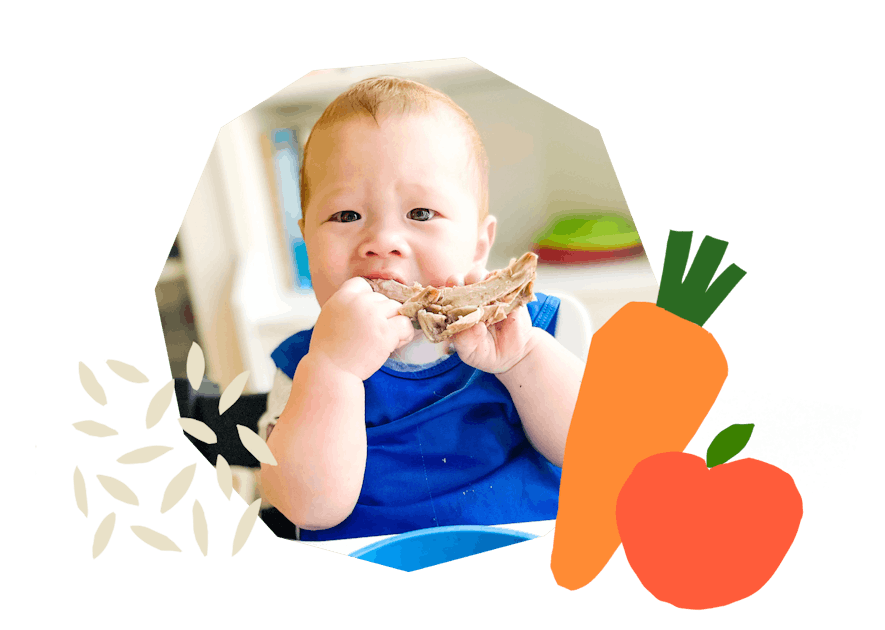
The Program Baby-Led Weaning with Katie Ferraro
A step-by-step digital program for starting solid foods safely and navigating the original 100 FIRST FOODS™ meal plan with baby-led weaning.
 EXPERT-LED, PROVEN APPROACH TO EATING REAL FOOD
EXPERT-LED, PROVEN APPROACH TO EATING REAL FOOD CONCISE VIDEO TRAININGS TO MASTER BABY-LED WEANING
CONCISE VIDEO TRAININGS TO MASTER BABY-LED WEANING 100 FIRST FOODS DAILY MEAL PLAN WITH FOOD PREP VIDEOS
100 FIRST FOODS DAILY MEAL PLAN WITH FOOD PREP VIDEOS
Baby-Led Weaning for Beginners Free Workshop
Is your baby ready to start solid foods, but you’re not sure where to start? Get ready to give your baby a solid foundation to a lifetime of loving real food…even if you’re feeling overwhelmed or confused about this next stage of infant feeding.
Get baby-led weaning recipes and tips delivered to your email inbox.

